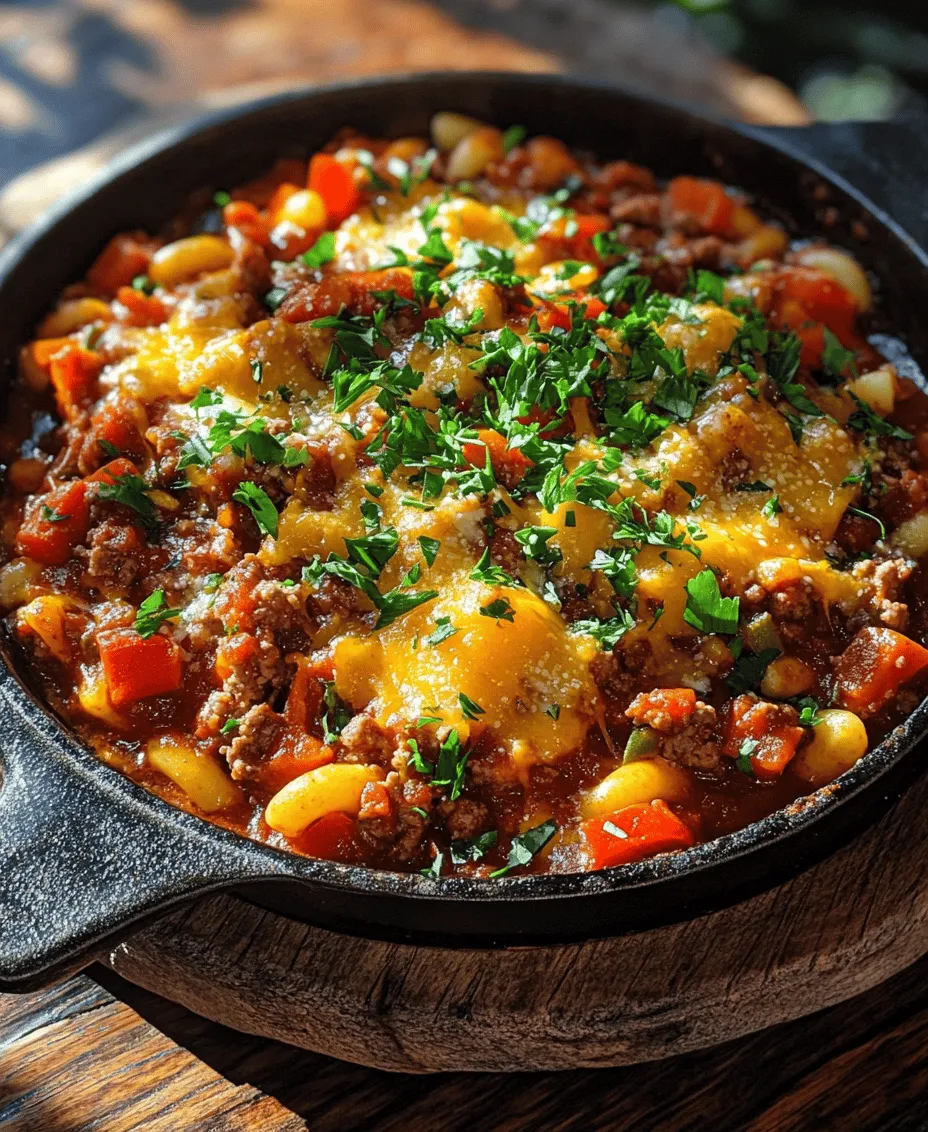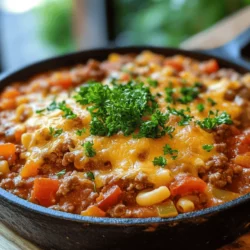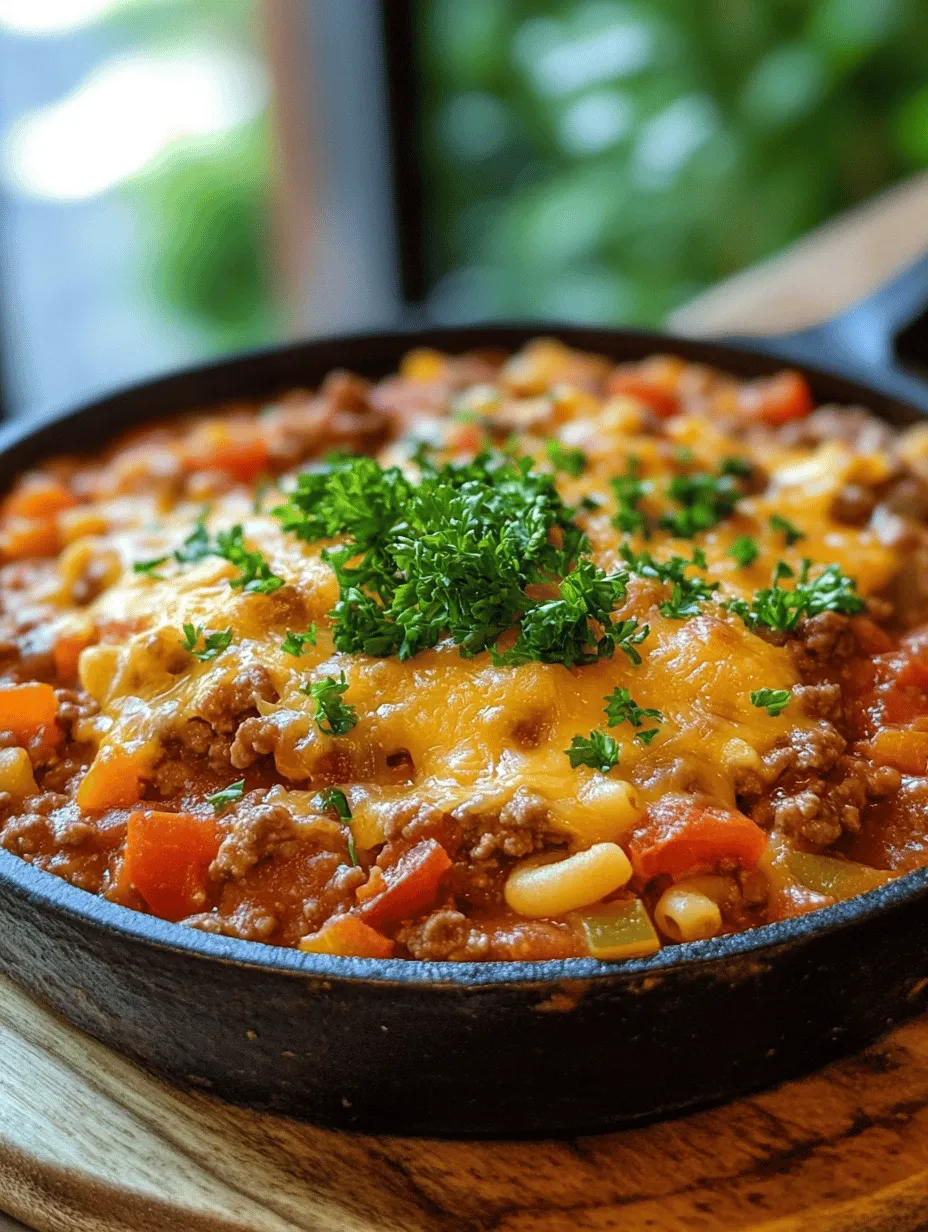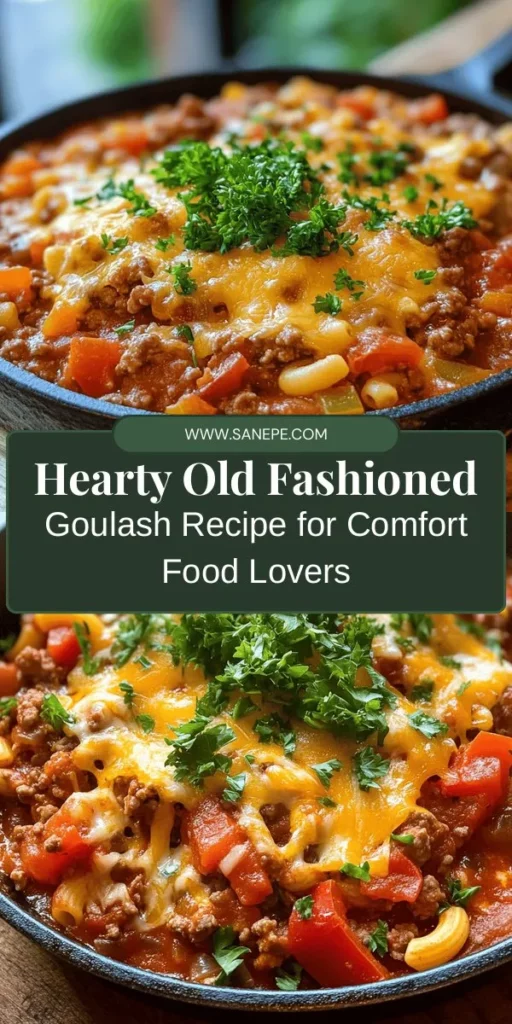Introduction
Understanding the roots and evolution of classic comfort food is essential to appreciating its place in our culinary landscape. One such dish that has stood the test of time is Old Fashioned Goulash. This hearty meal, rich in flavor and history, brings warmth and satisfaction to the dinner table, making it a favorite for families everywhere. Goulash is more than just a meal; it’s a story of tradition, family gatherings, and the comforting embrace of home-cooked food.
Originating from Hungary, goulash has evolved over centuries, adapting to various tastes and ingredient availability while maintaining its essence as a filling, savory dish. In this article, we will explore the ingredients, preparation steps, and the significance of Old Fashioned Goulash, while also delving into its variations and serving suggestions.
The Essence of Old Fashioned Goulash
Exploring the Origins of Goulash
Goulash has a rich history that dates back to the 9th century, when Hungarian shepherds cooked a simple stew of meat and vegetables in a cauldron over an open fire. The dish was originally made with beef, but as it traveled through various regions, different proteins and ingredients were incorporated, reflecting local tastes and resources. The use of paprika became synonymous with goulash, providing that distinctive flavor and vibrant color that has made this dish a staple in many households.
As goulash made its way across Europe, it took on different forms. In Austria, for example, the dish became more refined, often including wine and sour cream. In the United States, particularly during the Great Depression, goulash morphed into a budget-friendly meal featuring ground beef, pasta, and canned tomatoes, becoming a beloved comfort food for many families.
The Traditional Appeal of Goulash
The traditional appeal of goulash lies in its ability to bring people together. It’s a dish that evokes memories of family dinners and gatherings, where the aroma wafts through the home, promising a hearty meal that will satisfy everyone’s hunger. The emotional connection many people have with goulash is undeniable; it represents warmth, comfort, and a sense of belonging.
From a nutritional perspective, goulash is packed with ingredients that contribute to its hearty nature. The combination of protein from the meat, carbohydrates from the pasta, and vitamins and minerals from the vegetables makes it a balanced meal that can nourish the body and soul. As a one-pot dish, it also offers convenience, making it an ideal choice for busy weeknights or leisurely Sunday dinners.
Ingredients Breakdown
Understanding each component of the recipe is crucial for achieving the perfect Old Fashioned Goulash. Let’s take a closer look at the key ingredients that contribute to its rich flavor and satisfying texture.
Ground Beef: Selecting Quality Meat
The foundation of Old Fashioned Goulash is quality ground beef, which provides protein and a rich, savory flavor. When selecting ground beef, look for meat that is around 80% lean and 20% fat. This balance ensures that the beef remains juicy during cooking, adding depth to the overall dish. Freshness is vital, so opt for meat from a reputable butcher or grocery store.
The Role of Onions and Garlic in Flavor Development
Onions and garlic are essential aromatics that form the flavor base of goulash. Onions add sweetness and depth, while garlic contributes a robust flavor that enhances the overall taste profile. Sautéing these ingredients until they are translucent allows their natural sugars to caramelize, creating a rich foundation for the rest of the dish.
Red Bell Pepper: Adding Color and Sweetness
Red bell peppers are a delightful addition to Old Fashioned Goulash, providing not only a pop of color but also a hint of sweetness. Their crisp texture contrasts nicely with the tender beef and pasta, making each bite more enjoyable. When sautéed, red bell peppers become tender and flavorful, further enhancing the dish.
The Importance of Tomatoes in Goulash
Tomatoes are a critical component of Old Fashioned Goulash, contributing acidity and moisture to the dish. Whether you choose to use canned diced tomatoes, tomato sauce, or fresh tomatoes, their presence is non-negotiable. The acidity of the tomatoes balances the richness of the beef, creating a harmonious flavor profile that is both comforting and satisfying.
Elbow Macaroni: A Classic Choice for Texture
Elbow macaroni is the traditional pasta used in Old Fashioned Goulash, offering a chewy texture that pairs well with the other ingredients. Its small size allows it to soak up the flavorful sauce, ensuring that each bite is filled with deliciousness. While elbow macaroni is the classic choice, feel free to experiment with other pasta shapes, such as penne or rotini, if desired.
Beef Broth vs. Water: Why Broth Enhances Taste
When it comes to cooking goulash, using beef broth instead of water can significantly elevate the flavor of the dish. Broth is rich in umami, which adds depth and complexity to the goulash. If you don’t have beef broth on hand, homemade or store-bought chicken broth can also work as a substitute, though it may yield a slightly different flavor.
Seasoning Essentials: Paprika and Italian Seasoning
No goulash is complete without the right seasonings. Paprika is the star spice in this dish, providing a smoky undertone and vibrant color. Choose sweet paprika for a milder flavor or smoked paprika for a deeper taste. Additionally, Italian seasoning—a blend of herbs such as oregano, basil, and thyme—complements the goulash beautifully, enhancing the overall flavor profile.
Step-by-Step Instructions
Now that we’ve broken down the essential ingredients for Old Fashioned Goulash, let’s dive into the step-by-step instructions for preparing this comforting dish. Follow these detailed steps to ensure that your goulash turns out perfectly every time.
1. Gather Your Ingredients: Before starting, make sure you have all the necessary ingredients on hand. This will streamline the cooking process and allow you to focus on creating a delicious meal.
2. Sauté the Aromatics: In a large pot or Dutch oven, heat a tablespoon of olive oil over medium heat. Add the diced onions and minced garlic, sautéing until the onions become translucent and fragrant. This step is crucial for developing the flavor base of your goulash.
3. Brown the Ground Beef: Add the ground beef to the pot, breaking it up with a wooden spoon. Cook until the beef is browned and no longer pink, about 5-7 minutes. Drain any excess fat if necessary, although a little fat can add flavor to the dish.
4. Incorporate the Vegetables: Stir in the diced red bell pepper and cook for an additional 2-3 minutes, allowing the peppers to soften slightly. This will add a nice crunch and sweetness to the goulash.
5. Add the Tomatoes and Broth: Next, pour in the canned diced tomatoes (with their juices) and the beef broth. Stir well to combine, scraping up any browned bits from the bottom of the pot for added flavor.
6. Season the Mixture: Sprinkle in the paprika, Italian seasoning, and a pinch of salt and pepper. Adjust the seasoning to taste, keeping in mind that you can always add more later.
7. Bring to a Simmer: Bring the mixture to a gentle simmer, then reduce the heat to low. Cover the pot and let it simmer for about 15 minutes to allow the flavors to meld and develop.
8. Cook the Pasta: While the goulash simmers, cook the elbow macaroni according to the package instructions until al dente. Drain and set aside.
9. Combine the Pasta with the Goulash: After the goulash has simmered, stir in the cooked elbow macaroni. Mix well to ensure the pasta is evenly coated with the flavorful sauce. If the goulash seems too thick, add a little more broth or water to reach your desired consistency.
10. Final Taste Adjustments: Before serving, taste the goulash and adjust the seasoning as needed. A final sprinkle of paprika or a dash of hot sauce can elevate the flavors even further.
By following these steps, you’ll create a delicious pot of Old Fashioned Goulash that is sure to become a family favorite. Stay tuned for the next part of this article, where we’ll explore tips for achieving the best results with your goulash and answer some common questions about this beloved dish.

Browning the Ground Beef: Techniques for Optimal Flavor
Browning the ground beef is a foundational step in preparing Old Fashioned Goulash. This process not only adds a deep, rich flavor to the dish but also creates those coveted browned bits that enhance the overall taste. Start by heating a large skillet or pot over medium-high heat. Once hot, add your ground beef, breaking it apart with a spatula.
For optimal browning, allow the meat to sear without stirring for a few minutes. This helps develop a caramelized crust, which is full of flavor. After a few minutes, stir the meat occasionally until it is fully cooked through and no longer pink. If you notice excess grease, you can drain some off, but retain a little for flavor. Season the beef lightly with salt and pepper during this step to elevate the flavor profile. This simple technique sets the stage for the savory depth that characterizes a classic goulash.
Sautéing Vegetables: Achieving the Right Texture and Aroma
Once the ground beef is browned to perfection, it’s time to add the vegetables. Onions, garlic, and bell peppers are traditional choices that bring both flavor and texture to your goulash. Add a tablespoon of olive oil to the skillet if needed, and then toss in your chopped onions. Sauté them until they become translucent, which should take about 4-5 minutes.
Next, add minced garlic and diced bell peppers to the mix, cooking for an additional 3-4 minutes. This step is crucial as it allows the vegetables to soften while releasing their natural sweetness, creating a fragrant base for your goulash. The key here is to avoid overcooking; you want the vegetables tender but still retaining some crunch to contrast the softness of the pasta and meat. Once this aromatic base is ready, you’re set to combine the ingredients for the next step.
Combining Ingredients: Ensuring Even Distribution of Flavors
Now that you have a flavorful meat and vegetable mixture, it’s time to marry all the components together. Begin by adding your canned tomatoes, tomato paste, and beef broth to the skillet. Stir well to combine all ingredients, ensuring that the meat and vegetables are evenly distributed throughout the mixture.
Next, sprinkle in your dried herbs, including oregano, basil, and a bay leaf for added depth. These herbs are essential for creating the authentic taste of goulash. At this stage, you can also add a splash of Worcestershire sauce for an extra umami boost. Stir thoroughly and let the mixture simmer for about 10 minutes, allowing the flavors to meld beautifully. This simmering period also helps to reduce the acidity of the tomatoes and enhances the overall richness of the dish.
Cooking the Macaroni: Timing for the Perfect Al Dente
After your goulash mixture has simmered and the flavors have developed, it’s time to add the macaroni. The type of pasta you choose can influence the final texture, but elbow macaroni is the classic choice. Bring a separate pot of salted water to a boil and cook the macaroni according to package instructions, stopping just before it reaches the al dente stage; this is typically one or two minutes less than the recommended cooking time.
Once the pasta is cooked, drain it and add it directly into the goulash mixture. Stir well to combine, ensuring that the pasta absorbs the rich flavors of the sauce. Allow the entire mixture to simmer for an additional 5-10 minutes, which will help the pasta finish cooking and soak up the delicious broth. This final step leads to a perfectly cohesive dish where every bite is infused with flavor.
Tips for Perfecting Your Goulash
*Adjusting Flavors and Textures*
To ensure your Old Fashioned Goulash is nothing short of spectacular, consider these tips for adjusting flavors and textures to your liking.
– Customizing Seasoning to Taste: Taste your goulash before serving and adjust the seasoning as needed. A pinch of sugar can balance out acidity, while additional salt and pepper can enhance overall flavor. If you enjoy a bit of heat, consider adding red pepper flakes or a dash of hot sauce to elevate the dish.
– Cheese Options: For a creamy and rich finish, consider adding shredded cheddar cheese right before serving. The warmth of the goulash will melt the cheese, creating a deliciously gooey topping that contrasts beautifully with the savory elements of the dish.
– Garnishing Ideas: Fresh herbs can elevate the presentation and flavor of your goulash. A sprinkle of freshly chopped parsley or chives adds a pop of color and freshness that brightens the dish.
Serving Suggestions
Old Fashioned Goulash is not just a meal; it’s an experience. Here are some ideas on how to serve and enjoy it best:
– Ideal Accompaniments: Pair your goulash with crusty bread or garlic bread to soak up the delicious sauce. A light green salad can provide a refreshing contrast to the hearty goulash.
– Best Practices for Reheating Leftovers: Goulash often tastes even better the next day as the flavors continue to meld. When reheating, add a splash of water or broth to maintain moisture and prevent it from drying out. Heat gently on the stovetop or in the microwave until warmed through.
– Meal Prepping and Storage Advice: This dish is perfect for meal prep! Store leftovers in an airtight container in the refrigerator for up to 3-4 days. You can also freeze portions in freezer-safe containers for up to 3 months. Just be sure to label them with the date for reference.
Variations of Old Fashioned Goulash
Exploring variations of Old Fashioned Goulash can lead to exciting new flavors and interpretations of this beloved dish:
– Vegetarian Goulash: For a meatless alternative, substitute ground beef with lentils or a mixture of mushrooms and beans. This option still delivers a hearty texture while being plant-based.
– Spicy Goulash: If you enjoy a bit of heat, consider adding diced jalapeños or crushed red pepper flakes to your goulash. This variation adds a delightful kick that can elevate the entire dish.
– International Goulash Styles: Goulash has many interpretations around the world. For example, Hungarian goulash is typically more soup-like, featuring a rich broth flavored with paprika, while American-style goulash often includes more pasta and is thicker. Explore these variations to find your favorite version of this classic dish.
Conclusion
Old Fashioned Goulash is more than just a recipe; it’s a dish steeped in history and love. Whether you’re preparing it for a family dinner or sharing it with friends, its comforting flavors and heartwarming essence make it a staple in many households. Understanding its ingredients, preparation process, and variations allows home cooks to appreciate this timeless meal even more. Embrace the tradition of goulash in your kitchen and savor the rich flavors that have delighted generations. Cooking goulash is not just about feeding the body; it’s about nourishing the soul. So gather your ingredients, follow these steps, and enjoy the warmth and comfort that a bowl of Old Fashioned Goulash brings to your table.


